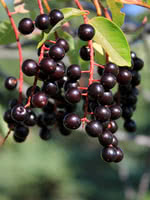Mon-Fri 9am - 5pm Mountain time
Western Chokecherry vs Wild Snowberry
Prunus virginiana var. demissa
Symphoricarpos spp.
CUSTOM GROW
Western Chokecherry is a shrub or small tree commonly used for farmstead and field windbreaks.
It produces white flowers in the spring and edible dark purple fruit that matures between September and October. Its cherries are great for making for making jams, jellies or wine, but are not very palatable for raw eating.
Wild Snowberry is a mix of Common Snowberry and Western Snowberry. Each shrub's size, flower, and berry colour may vary.
This plant is abundant across the prairies. It can be planted alone or as a hedge in small yards. This shrub's ornamental berries persist into winter. Wild Snowberry can be a natural habitat and food source for various animals.
Western Chokecherry Quick Facts
Wild Snowberry Quick Facts
Toxicity: toxic to horses, cattle, etc.)

